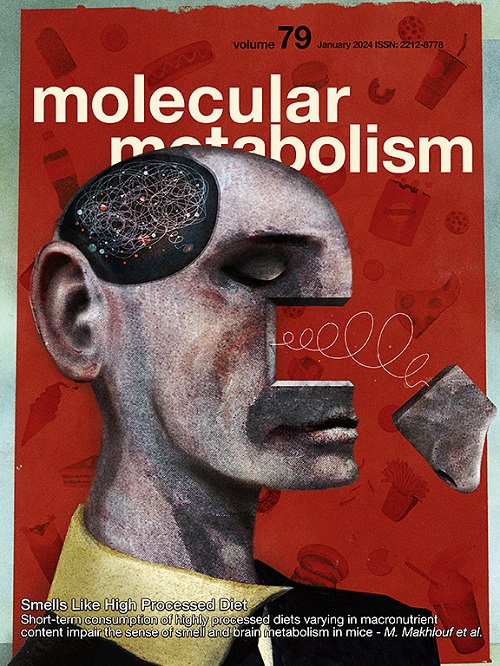Functional regulation of macrophages by Ces1d-mediated lipid signaling in immunometabolism
IF 6.6
2区 医学
Q1 ENDOCRINOLOGY & METABOLISM
引用次数: 0
Abstract
Objective
Macrophage accumulation in metabolically active tissues during obesity is common in both animals and humans, but the lipid signaling mechanisms that trigger macrophage inflammation remain unclear. This study investigates the role of Ces1d, an unconventional lipase, in regulating macrophage inflammation under nutritional stress.
Methods
A myeloid-specific Ces1d knockout (LysM-Cre-Ces1d floxed/floxed, KO) mouse model was used for the studies. For in vitro tests, bone marrow-derived macrophages (BMDMs) from control (Ces1d floxed/floxed, WT) and KO mice were assessed for migration, polarization, and activation. For in vivo experiments, WT and KO mice were induced to obesity via a high-fat diet (HFD) and subjected to metabolic characterization. Adipose tissue, liver, and serum samples were analyzed histologically and biochemically. Endogenous macrophages and T cells from adipose tissue were isolated and analyzed for functional interactions by flow cytometry.
Results
Ces1d expression changes during the differentiation of monocytes into macrophages in both mice and humans. Loss of Ces1d causes larger lipid droplets, with increased accumulation of triacylglycerol (TAG) and diacylglycerol (DAG), and impaired lipid signaling in KO macrophages. Lipid dysregulation in macrophages triggers pro-inflammatory activation, enhancing migration, activation, and polarization toward an M1-like phenotype. The pro-inflammatory macrophages further promote CD3+CD8+ T cell accumulation in obese adipose tissue, which contributes to worsened metabolic disorders, including more severe fatty liver, increased local inflammation in adipose tissue, and impaired systemic glucose tolerance in KO mice on a high-fat diet.
Conclusions
This study demonstrates Ces1d is a crucial factor in maintaining lipid homeostasis in macrophages. Loss of Ces1d leads to metabolic dysregulation in macrophages and other immune cells during obesity.
ces1d介导的脂质信号在免疫代谢中对巨噬细胞功能的调节
目的:肥胖期间巨噬细胞在代谢活跃组织中的积累在动物和人类中都很常见,但引发巨噬细胞炎症的脂质信号传导机制尚不清楚。本研究探讨了一种非常规脂肪酶Ces1d在营养应激下调节巨噬细胞炎症中的作用。方法:采用骨髓特异性Ces1d敲除(LysM-Cre-Ces1d floxed/floxed, KO)小鼠模型进行研究。在体外实验中,我们评估了来自对照组(Ces1d floxed/floxed, WT)和KO小鼠的骨髓源性巨噬细胞(bmdm)的迁移、极化和活化情况。在体内实验中,WT和KO小鼠通过高脂肪饮食(HFD)诱导肥胖,并进行代谢表征。对脂肪组织、肝脏和血清样本进行组织学和生化分析。从脂肪组织中分离内源性巨噬细胞和T细胞,并通过流式细胞术分析其功能相互作用。结果:小鼠和人单核细胞向巨噬细胞分化过程中,Ces1d表达发生变化。Ces1d的缺失导致更大的脂滴,增加三酰甘油(TAG)和二酰甘油(DAG)的积累,并损害KO巨噬细胞的脂质信号。巨噬细胞的脂质失调触发促炎激活,增强迁移、激活和向m1样表型的极化。促炎巨噬细胞进一步促进CD3+CD8+ T细胞在肥胖脂肪组织中的积累,导致代谢紊乱恶化,包括更严重的脂肪肝,脂肪组织局部炎症增加,以及高脂肪饮食下KO小鼠的全身糖耐量受损。结论:Ces1d是维持巨噬细胞脂质稳态的重要因素。肥胖期间,Ces1d的缺失导致巨噬细胞和其他免疫细胞代谢失调。
本文章由计算机程序翻译,如有差异,请以英文原文为准。
求助全文
约1分钟内获得全文
求助全文
来源期刊

Molecular Metabolism
ENDOCRINOLOGY & METABOLISM-
CiteScore
14.50
自引率
2.50%
发文量
219
审稿时长
43 days
期刊介绍:
Molecular Metabolism is a leading journal dedicated to sharing groundbreaking discoveries in the field of energy homeostasis and the underlying factors of metabolic disorders. These disorders include obesity, diabetes, cardiovascular disease, and cancer. Our journal focuses on publishing research driven by hypotheses and conducted to the highest standards, aiming to provide a mechanistic understanding of energy homeostasis-related behavior, physiology, and dysfunction.
We promote interdisciplinary science, covering a broad range of approaches from molecules to humans throughout the lifespan. Our goal is to contribute to transformative research in metabolism, which has the potential to revolutionize the field. By enabling progress in the prognosis, prevention, and ultimately the cure of metabolic disorders and their long-term complications, our journal seeks to better the future of health and well-being.
 求助内容:
求助内容: 应助结果提醒方式:
应助结果提醒方式:


